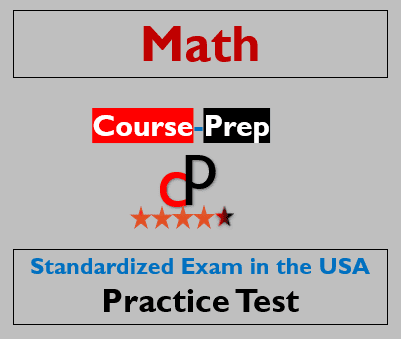Math Practice Test 2024 (Standardized Exam in the USA): Try or free a Mathematics practice test online without any registration. You can also download the worksheet in printable PDF.
Start your mathematics practice by taking the Mathematics Pretest for free. It will help you decide which category of math will be most valuable to you. You will also see some samples of the technology-enhanced question formats that appear on the actual exam (like SAT, ACT, GED, etc.).
Take the Math Practice Test 2024 in a controlled environment, with as few distractions as possible. Use a calculator, and if you want to simulate testing conditions, limit yourself to certain minutes, although you may prefer to take the test untimed in order to get a chance to think about every problem.
When you are done, or when time is up, check your answers in the Answers and Solutions directly following the Math Practice Test 2024, where you will find short explanations of a correct approach to each problem. Next, find the problem numbers you answered incorrectly in the Evaluation Chart to identify the chapters on which you need to concentrate.
Math Practice Test 2024
Each of the following tests consists of an exercise of 50 problems on a different individual topic in mathematics. The number of problems is intended to expose you to a variety of contexts and situations in which various mathematical problems arise.
The exercises are not intended to be timed, but if you find that you are familiar with a topic, you could try timing yourself on a few problems, attempting to correctly work 5 problems in 10 minutes, for example. Answers and Solutions for the problems in the exercises are located directly following the last practice tests.
Our Math Practice Test 2024 is a computer-based test, which allows for a broad range of item types. There are many multiple-choice items, each of which has four answer choices from which to choose. There are also many technology-enhanced items with formats such as fill-in-the-blank, drop-down, hot spot, and drag-and-drop.
Math Practice Test Topics
About 45 percent of the problems on the test are quantitative, including problems using whole numbers, negative numbers, fractions, decimals, and percentages to answer questions on calculations, conversions, exponents, word problems, rates, ratios, proportions, counting, probability, statistics, data analysis, the Pythagorean theorem, and the perimeter, area, surface area, and volume of geometric objects.
1. Place Value and Rounding: Know how to identify digits by place value and round values to a place value.
2. Number Line and Negatives: Know how to read a number line and understand negative numbers.
3. Order of Operations: Follow the order of operations (PEMDAS) when doing calculations.
4. Roots and Exponents: Perform operations with exponents, including negative exponents. Know the value of basic square roots and cube roots. Simplify roots.
5. Fractions: Perform operations with fractions; change between improper and mixed fractions; and convert fractions to decimals and percents.
6. Decimals: Perform operations with decimals and convert decimals to fractions and percents.
7. Ratios and Proportions: Understand how ratios and proportions work; do word problems involving ratios and proportions; reduce ratios; find the missing value in a proportion.
8. Rates: Understand how rates work; do word problems involving rate; reduce rates.
9. Percent: Convert percents to decimals and fractions. Solve problems involving percent, including calculating interest.
10. Measures of Central Tendency: Find the mean, median, mode, and range of a data set.
11. Probability and Combinations: Understand probability; find the probability of a single event; find the probability of compound events; find the number of possible combinations of things.
12. 2-Dimensional Figures: Find the area and perimeter of 2D figures.
13. 3-Dimensional Figures: Find the area, surface area, and volume of 3D figures.
14. Polynomials: Combine like terms; add and subtract polynomials.
15. Multiplying Polynomials: Multiply single terms; use the FOIL method to multiply binomials; multiply polynomials with more than two terms.
16. Factoring Polynomials: Factor out the greatest common factor; use reverse FOIL; use the difference of squares.
17. Rational Expressions: Simplify, add, subtract, multiply, and divide rational expressions.
18. Equations and Inequalities: Write and solve linear equations and inequalities; graph inequalities.
19. Systems of Equations: Solve systems of two equations with two unknowns.
20. Quadratic Equations: Solve quadratic equations with the square root rule, by factoring, and with the quadratic formula.
21. Translating Word Problems: Turn a word problem into a mathematical calculation or equation and solve it.
22. Graphing: Plot points; graph lines; find the intercepts of a line.
23. Line Equations: Find the equation of a line from two points or from one point and the slope.
24. Slope: Find the slope of a line from a graph of the line, from the equation of the line, or with two points on the line.
25. Functions: Evaluate functions (find the given value); recognize a function from a table or a graph; identify when a graphed function is positive, negative, increasing, or decreasing; determine the period of a function from a graph.
Visit http://www.atomiclearning.com/ti30xs for more information about using the calculator, including instructions on some of the advanced features.

